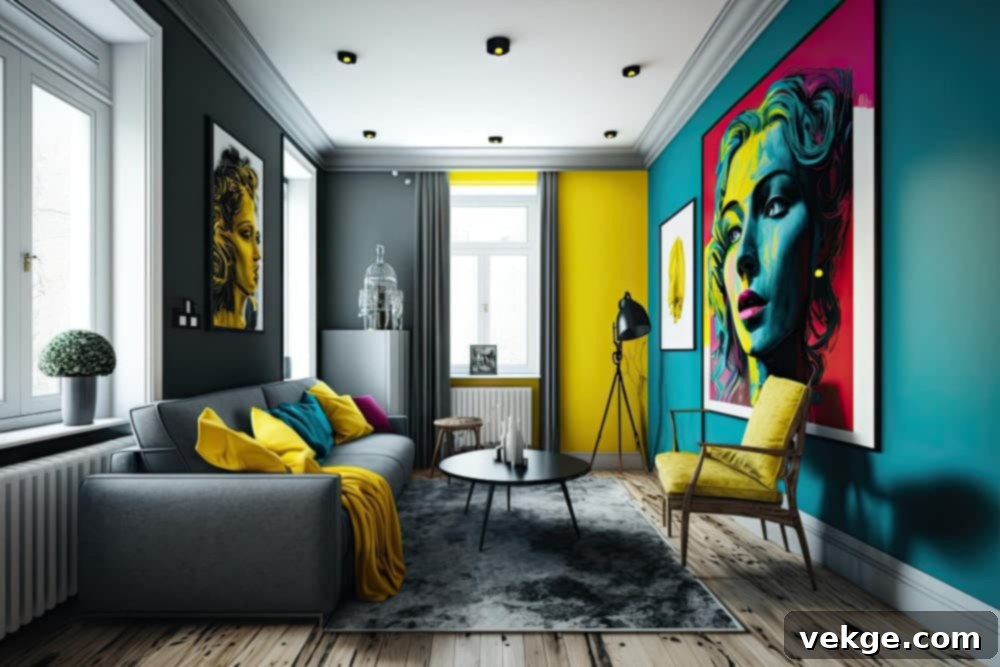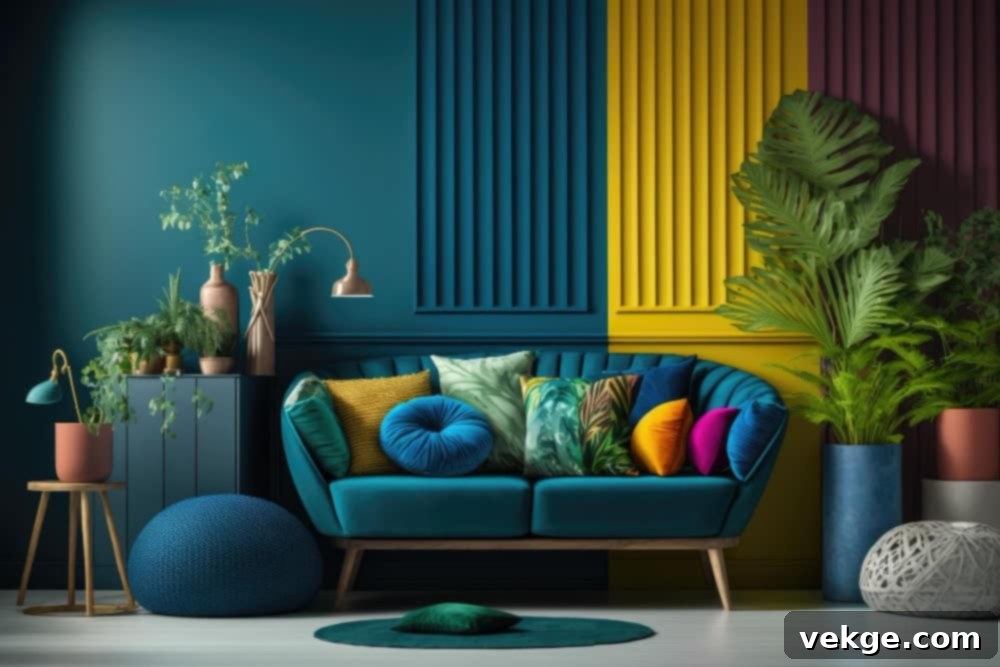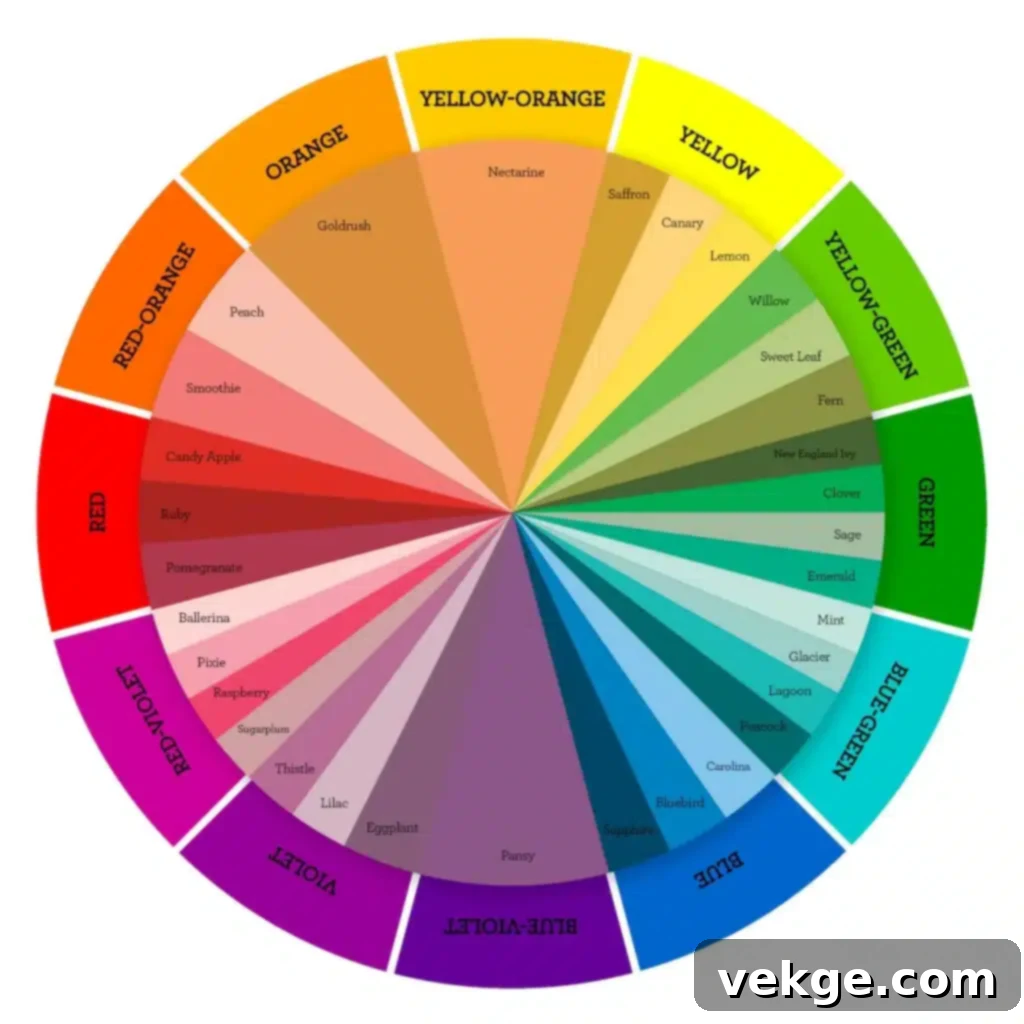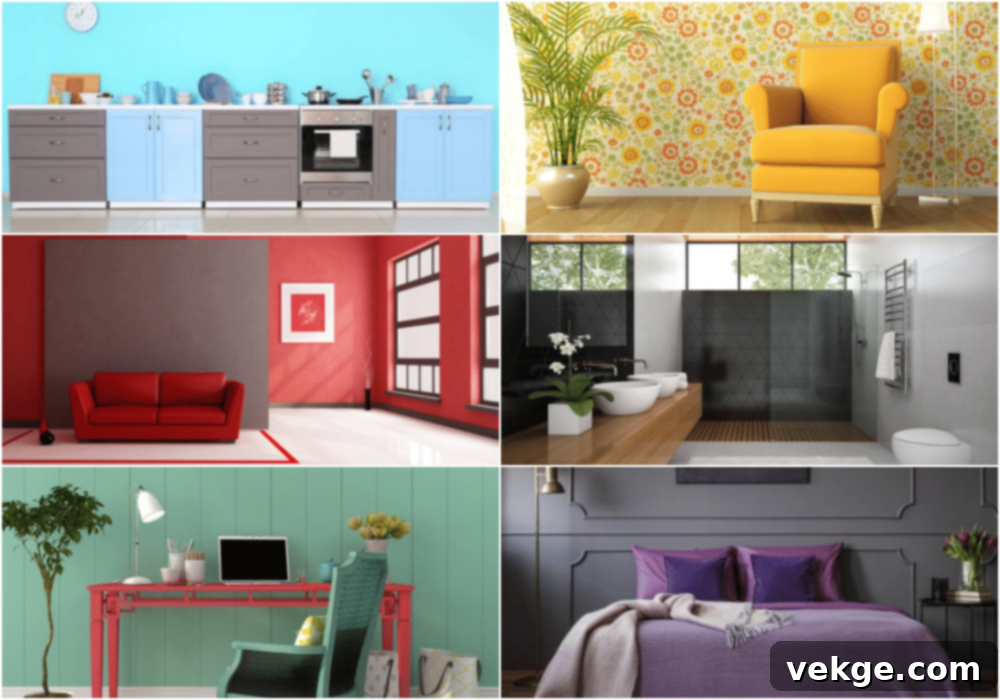Transform Your Home: A Comprehensive Guide to Color Psychology in Interior Design
The aesthetic appeal of a home is a delicate balance of many elements, from furniture placement to lighting choices. However, perhaps the most defining and impactful component of all is color. More than just a visual choice, the colors that adorn our walls and fill our spaces have a profound psychological effect, shaping our moods, influencing our behavior, and ultimately determining how we experience our living environment.
While home decoration trends come and go, the timeless power of paint colors remains undeniable. They are the silent architects of emotion within our homes, capable of evoking energy, serenity, warmth, or coolness. Understanding this intricate relationship between color and human psychology is not merely a design preference; it’s a fundamental aspect of creating spaces that truly resonate with us.
Every hue carries a unique psychological blueprint, affecting us in subtle yet significant ways. This makes thoughtful color selection paramount when envisioning your ideal home. To help navigate this fascinating world, this comprehensive guide will delve deep into color psychology, exploring its scientific underpinnings and practical applications in home decor. Get ready to unlock the secrets to designing a home that not only looks stunning but also feels perfectly aligned with your desired mood and lifestyle.
Unveiling Color Psychology: More Than Just Hues
Before we explore the specific applications of color in interior design, it’s crucial to grasp the science and theory behind color psychology itself. This field studies how different colors can affect human behavior, mood, and even physical reactions. It’s a powerful tool that, when understood, allows us to intentionally craft environments that support our well-being and daily activities.

The Scientific Rationale Behind Color Perception
Our perception of color begins when light, composed of various wavelengths, strikes an object and then reflects into our eyes. Specialized cells in our retinas, called cones, are responsible for detecting these different wavelengths. The brain then interprets these signals as distinct colors.
The fascinating part is how these wavelengths correlate with psychological responses. For instance, warm colors like vibrant reds and energetic oranges possess shorter wavelengths. These colors are often associated with stimulation, passion, and excitement. They can increase heart rate, evoke feelings of warmth, and even stimulate appetite, making them popular choices for dining areas.
Conversely, cool colors such as soothing blues and calming greens typically have longer wavelengths. These hues are consistently linked with feelings of tranquility, relaxation, and serenity. They can reduce stress, promote focus, and create a sense of spaciousness, making them ideal for bedrooms and bathrooms.
Beyond these general categories, the nuances of each specific color offer a vast palette of emotional and psychological potential. It’s this intricate interplay that makes exploring how colors can transform the ambiance of a space so captivating. Speaking of which, if you’re interested in how a bold and often misunderstood color like black can be creatively used in interior design to add depth, elegance, and a unique aesthetic, don’t miss our article on wall paint ideas. It delves into how even the darkest shades can be strategically employed to create powerful visual statements.
Color Psychology: The Cornerstone of Intentional Interior Design
Understanding color psychology is paramount for interior designers and homeowners alike because it provides a framework for creating spaces that are not only visually appealing but also emotionally resonant and functionally appropriate. It’s the art of manipulating an environment’s atmosphere through conscious color choices.
The efficient application of color psychology ensures that the chosen palette actively supports the intended purpose of a room. For example, a bedroom designed for relaxation will benefit immensely from calming blues or greens, while a creative workspace might thrive with stimulating yellows or oranges. This strategic approach elevates interior design beyond mere aesthetics, transforming a house into a home that genuinely influences behavior, enhances mood, and fosters a sense of comfort and well-being.
Thoughtful color selection can literally make or break a room’s ambiance. It sets the tone, defines the energy, and even dictates how occupants interact within the space. Every color has a distinct role to play in igniting specific emotions and shaping the overall perception of your home. Below, we’ve outlined some of the most prominent colors and their psychological impact, along with how they can be effectively utilized in interior design.
- White: Purity and Spaciousness
White is universally associated with purity, simplicity, and cleanliness. It brings a sense of calmness and a peaceful, uncluttered approach to any room. One of its most powerful attributes is its ability to make a room feel significantly bigger, brighter, and more open by reflecting light. While offering a minimalist appeal, too much stark white can sometimes feel sterile or uninviting; balancing it with textures and accent colors is key. - Red: Energy and Passion
If your goal is to make a bold statement and inject energetic, passionate vibes into a space, red is an unparalleled choice. This powerful color is known to increase excitement, stimulate conversation, and even boost appetite. Often used as an accent color in interiors, red can add warmth, depth, and a dramatic focal point. However, in large doses, it can be overstimulating, so strategic application in areas like dining rooms or as an accent in living spaces is often most effective. - Blue: Serenity and Focus
Blue is widely regarded as a calming and soothing color, creating an immediate sense of serenity and tranquility. Lighter shades of blue are particularly effective in making a room feel expansive and airy, reminiscent of the sky or ocean. Its calming properties make it one of the most preferred options for bedrooms and bathrooms, where relaxation is paramount. Darker blues can evoke feelings of trust, stability, and even boost productivity in home offices. - Green: Harmony and Growth
As the color most closely associated with nature, green brings a sense of balance, harmony, and renewal to any interior. It is incredibly soothing, reduces stress, and promotes a feeling of freshness and well-being. Different shades of green can offer varied effects: soft sage greens for tranquility, vibrant lime greens for energy, and deep forest greens for sophistication and grounding. It’s an excellent choice for living rooms, bedrooms, and even kitchens, offering versatility and a natural connection. - Yellow: Joy and Optimism
Yellow is the color of sunshine, happiness, and optimism. It’s incredibly uplifting and can bring a sense of warmth and energy to a space. Lighter yellows are excellent for creating a cheerful and inviting atmosphere, particularly in kitchens, breakfast nooks, or entryways. However, bright or overly saturated yellows can sometimes be overwhelming or induce anxiety if not used thoughtfully. Best used in moderation or in softer tones to maintain its positive impact. - Orange: Enthusiasm and Creativity
Orange is a vibrant and enthusiastic color that combines the energy of red with the happiness of yellow. It evokes feelings of warmth, excitement, and creativity, making it an excellent choice for stimulating environments. It’s often associated with social interaction and can be a wonderful addition to living rooms or creative studios. Like red, it’s powerful and often best used as an accent or in more muted, earthy tones to avoid overwhelming the space. - Purple: Luxury and Creativity
Historically linked to royalty and luxury, purple also has strong associations with creativity, spirituality, and imagination. Deep purples can create a sophisticated and dramatic atmosphere, while lighter lavenders and lilacs offer a softer, more whimsical, and calming effect. It can be an intriguing choice for bedrooms, creative spaces, or as an elegant accent in living areas, adding a touch of mystique and grandeur. - Gray: Sophistication and Balance
Gray is the ultimate neutral, offering sophistication, balance, and versatility. It serves as an excellent backdrop, allowing other colors and design elements to truly shine. Depending on its undertones (warm or cool), gray can create a calming, modern, or industrial feel. While it can sometimes be perceived as dull, pairing it with pops of color, rich textures, or natural wood tones can transform it into an incredibly chic and inviting foundation for any room. - Brown/Neutrals: Earthiness and Comfort
Colors like brown, beige, tan, and taupe are grounding and provide a sense of stability, warmth, and comfort. They are deeply rooted in nature, evoking feelings of safety and reliability. These neutrals are incredibly versatile and form an excellent base for any decor style, from rustic to contemporary. They pair well with almost any accent color and are ideal for creating cozy, inviting spaces like living rooms and studies.
The Dynamic Role of Colors in Affecting Our Moods and Behaviors

Colors possess an undeniable and powerful influence on our moods and behaviors, shaping the very emotional stage of our daily lives within our homes. The difference in impact between warm and cool colors, for example, is striking and scientifically recognized. Warm colors tend to energize, stimulate, and make a space feel more intimate, while cool colors soothe, relax, and often create an illusion of spaciousness.
Understanding these inherent influences is not merely academic; it’s essential for bringing up the desired “color codes” for your home’s look and feel. Color is a crucial element of interior design precisely because it has the unique ability to transform a place, instantly establishing a specific mood or environment. It can subtly guide the eye, drawing attention to architectural details, establishing captivating focal points, and defining the overall aesthetic of an area.
Beyond individual color choices, the way colors interact within a room through carefully selected color schemes further amplifies their psychological effects. A harmonious scheme can promote tranquility, while a high-contrast scheme can inject vibrancy and dynamism. It’s this nuanced understanding that allows homeowners and designers to curate spaces that perfectly align with their functional needs and emotional desires, fostering a truly personalized and impactful living experience.
Strategic Color Placement: Designing for Purpose and Psychology
The selection of colors for your interior design must always begin with a deep consideration of the occupant’s desires and the room’s specific purpose. What kind of atmosphere do you wish to cultivate? What mood do you want to evoke? The answers to these questions are pivotal in guiding your color choices.
For instance, rooms dedicated to rest and relaxation, such as bedrooms, overwhelmingly benefit from calming and serene hues. Soft blues, gentle greens, and soothing lavenders are ideal for promoting sleep and reducing stress. Conversely, areas designed for focus and productivity, like a home office, might benefit from colors that stimulate the mind without overwhelming it – perhaps a balanced green or even a strategic use of a warmer tone to encourage creativity.
Living rooms, often the hub of social activity, demand colors that are inviting, comfortable, and versatile enough to accommodate various moods. Dining rooms, on the other hand, can benefit from warmer tones that stimulate conversation and appetite. Kitchens often thrive with bright, clean colors that promote a sense of hygiene and energy. Understanding these functional requirements ensures that color choices enhance, rather than detract from, a room’s intended use.
Different Color Schemes for Designing Your Interior
To achieve a cohesive and visually pleasing look, especially when incorporating a mixture of warm and cool tones, understanding color schemes is indispensable. Color schemes help complement one color with another effectively, bringing out the perfect combination and maximizing the psychological impact of your chosen palette. These systematic approaches to color selection ensure harmony and balance within your design.
There are several prominent varieties of common color schemes that help in exhibiting the best turn-up for any room; the three most fundamental and widely used are:
- Monochromatic Color Scheme: This elegant scheme utilizes various shades, tints, and tones of a single color. For example, a monochromatic blue scheme might include navy, sky blue, and powder blue. It creates a sophisticated, cohesive, and serene look, often promoting a sense of calm and unity without being dull if varied textures and patterns are incorporated.
- Analogous Color Scheme: This scheme uses colors that are positioned next to each other on the color wheel. For example, blue, blue-green, and green. Analogous schemes are inherently harmonious and pleasant to the eye, as the colors naturally blend. They create a rich, yet understated, flow within a space, evoking a sense of balance and nature.
- Complementary Color Scheme: This vibrant scheme combines two colors that are directly opposite each other on the color wheel, such as red and green, or blue and orange. Complementary colors offer the highest contrast, creating a highly dynamic and energetic effect. When used effectively, this scheme can make a room feel lively and dramatic, with each color making the other appear more vivid. It’s important to balance the dominant color with the accent color to prevent the space from feeling too overwhelming.

The Illusion of Space: How Colors Manipulate Perception
Beyond their emotional impact, colors hold immense potential in defining the physical perception of any space, fundamentally altering whether it appears larger or smaller, more open or more intimate. This optical illusion is a powerful tool in interior design, allowing you to manipulate the feel of a room without altering its physical dimensions.
For example, light colors like white, cream, pale grays, and soft blues are renowned for their ability to create an illusion of expansiveness. By reflecting more light, these hues make walls seem to recede, enhancing the airiness and openness of a room. They are particularly effective in smaller spaces or rooms with limited natural light, making them feel brighter and more inviting.
On the other hand, darker and richer colors, such as deep navy, maroon, charcoal gray, or even black, tend to absorb light. This characteristic makes walls appear to advance, creating a sense of compactness and enhancing intimacy. While these colors can make a large, cavernous room feel cozier and more sophisticated, they can also make a small room feel cramped if not used carefully. Strategic placement, such as an accent wall, can allow you to enjoy the depth of dark colors without overwhelming the space.
Moreover, color can influence the perceived height of a room. Painting ceilings a lighter color than the walls can make a room feel taller, while a darker ceiling can make it feel more intimate and cozier. Understanding these visual tricks allows homeowners to make perfect selections based on their preferences and the room’s specific requirements, bringing out the best possible look and feel.
It’s crucial to remember that not every color suits all setups. The ideal choice depends on the room’s size, natural light, intended function, and the overall aesthetic you wish to achieve. Experimentation, combined with an understanding of color psychology, is key to truly transforming your living environment.
Beyond the Paint Can: Incorporating Color Through Decor
While wall paint is the most obvious way to introduce color, the psychological impact of hues can also be achieved through various other decorative elements. Furniture, textiles, art, and accessories all play a vital role in layering color and reinforcing your desired mood and aesthetic without the commitment of a full repaint.
Consider using vibrant cushions, throws, or curtains to inject pops of energetic color into a neutral room. A bold piece of artwork can become a focal point and introduce a dominant color theme. Rugs can define zones and ground a space with a specific color palette. Even smaller items like vases, books, or decorative objects can contribute to the overall color scheme, adding depth and personality.
This approach offers flexibility, allowing you to easily update your home’s look and feel with seasonal changes or evolving personal tastes. It’s an excellent way to experiment with colors you might be hesitant to commit to on a larger scale, helping you discover what truly resonates with your psychological and aesthetic preferences.
Personal Preference and Cultural Considerations
While color psychology offers general guidelines, it’s important to acknowledge that individual and cultural preferences can significantly influence how colors are perceived and experienced. What one person finds calming, another might find dull, and what is stimulating in one culture might signify mourning in another.
Your personal history, memories, and associations with certain colors play a crucial role in how you react to them. A specific shade of blue might evoke fond memories of a childhood vacation, while for someone else, it might bring to mind a less pleasant experience. Therefore, while scientific principles provide a foundation, the ultimate success of your home decor lies in choosing colors that personally resonate with you and your household members, creating a truly unique and comfortable sanctuary.
Wrapping it Up: The Art of Thoughtful Color Selection
Overall, color psychology is not just an important element but a pivotal force in home decor, profoundly influencing both your space’s aesthetics and its underlying vibe. Every color, whether bold or subtle, plays a significant role in evoking emotions, shaping perceptions, and creating a specific atmosphere.
Neutral colors such as gray, peach, and beige offer incredible flexibility, providing a serene backdrop that allows other design elements—like furniture, artwork, and textiles—to shine and bring out the best in your room’s setup. They offer a sense of calm and sophistication, acting as a versatile foundation upon which more vibrant hues can be layered.
Ultimately, the choice of colors for your home is a deeply personal journey, merging individual taste with the scientific understanding of how colors affect us. It’s about getting the absolute best out of your space to achieve your desired mood and atmosphere, fostering a harmonious environment that supports your well-being. The psychological aspect of selecting colors impacts how you react to your surroundings and contributes significantly to your overall well-being and daily comfort.
In essence, the game of interior design, particularly concerning color, is all about informed perception and ideal choice. We sincerely hope this comprehensive color psychology guide has provided you with detailed clarity and underscored the immense importance of thoughtful color selection in transforming your home. Remember, your home is your sanctuary, and the colors you choose are instrumental in defining its character and your experience within it.
For any doubts or recommendations, please feel free to drop them in the comments below. We’d love to hear your thoughts and experiences with color in your own living spaces!
